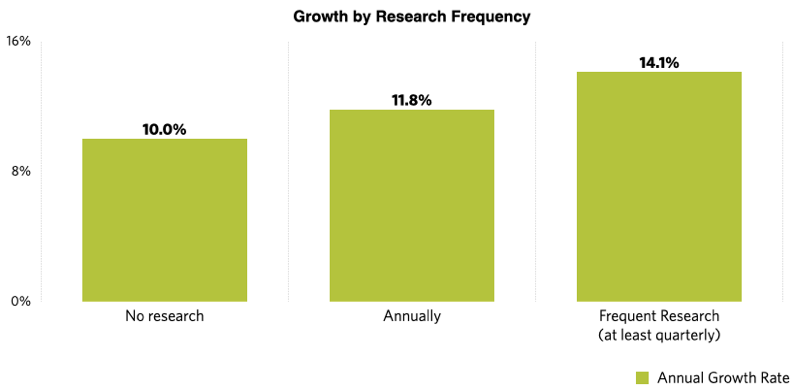Your Secret Weapon
Target Market Research
Why do some professional services firms grow faster than others? The 2020 High Growth Study provides insights on this topic—and on the impact of doing original research about one’s target audience. The author in this article shares the value of target marketing.

Why do some professional services firms grow faster than others? The 2020 High Growth Study provides insights on this topic—and on the impact of doing original research about one’s target audience.
The data is compelling. Simply put, firms that conduct frequent research on their target audiences grow faster. As shown in Figure 1, doing even occasional research accelerates growth—but conducting research at least quarterly is associated with over 40 percent faster growth.
Figure 1: Firm Growth, by Frequency of Research

There are two main reasons for this impact. First, when markets are undergoing rapid change and disruption, those firms with the best, most up-to-date understanding of their target clients’ needs and priorities have a competitive advantage.
Second, original target audience research is an essential ingredient in high value content. Your potential clients are interested in learning about key trends in their industries—especially when those insights are based on recent, credible research. A firm can deliver such insights to prospective clients using a variety of marketing channels (social media, trade publications, webinars, etc.), which makes research an effective core component of a content marketing program.
In short, doing research on your target audience not only gives you highly useful insight into your target audience and the topics they care about … it also can be converted into high-value content that you can use to attract and nurture leads.
Three Ways to Conduct Target Market Research
Basically, there are three ways to research your target markets, which I will discuss below. If you would like a more in-depth review of research options and strategies, check out Hinge’s guide to professional services research.
- Analyze your own firm’s experience.
In most professional services organizations, the professionals themselves have already acquired significant insights into their target audiences.
Of course, one individual’s opinion about target audiences is generally anecdotal and of limited value. However, if you systematically combine that person’s experience with those of many colleagues, it begins to assume greater value. For example, you could survey all your client-facing professionals about the issues their clients in a certain target market talk about.
Your financial management system could be another source of valuable insight—such as data about your clients’ average project size or payment histories. Likewise, your CRM system could provide interesting data on time to close or closing percentage.
Note, however, that there are also limitations to this type of direct operational experience. For one thing, it represents only a fraction of the larger market. It also reflects only what you have done in the past for the target audience, but not what is possible or preferred. Even so, direct experience is a great place to start and can point toward many research questions to explore.
- Secondary research.
In this method, you explore research on your target market that others have already done. Start by searching online for studies published by industry trade associations, government agencies, or private sector firms. Fortunately, there is a rich assortment of both free and paid sources covering many major industries. You can also use various online sources, including rating sites, social media, analysts’ reports, and industry growth projections.
Such secondary sources are great for assessing overall industry growth or key issues. The downside is that they may not focus on the particular industry segment you are targeting or the specific questions you want answered.
- Primary research.
In this approach, you determine the market segment you are researching and which specific information you are seeking. It is the best method for finding out how your firm is viewed by your target market, and which messaging and marketing approaches work best with your prime targets.
Primary research is usually conducted by an independent firm (full disclosure: my firm, Hinge, does a lot of such work for our clients). The independence aspect is very critical in getting accurate, unbiased responses. Even better is if the firm doing the research already has a lot of experience with your own industry, because that background can allow them to put your results in context.
Some of the most popular primary research methods are structured interviews, focus groups, and surveys. Generally, focus groups are not a good fit for professional services firms, since most executives are not forthcoming when they are in a group of direct competitors! Fortunately, individual interviews and surveys are a good option—and both have their strengths and limitations.
Primary research is perhaps the most direct way to reduce marketing risk. But of course, its value comes at a cost.
I hope this overview has whetted your appetite for using research to not only better understand the needs of your target audience, but also to create must-read material that can fuel your content marketing strategy. Now, go forth and conquer!
Lee W. Frederiksen, PhD, is Managing Partner at Hinge, the leading branding and marketing firm for the professional services. Hinge conducts groundbreaking research into high-growth firms and offers a complete suite of services for firms that want to become more visible and grow.
Dr. Frederiksen can be contacted at (703) 391-8870 or by e-mail to LFrederiksen@hingemarketing.com.








